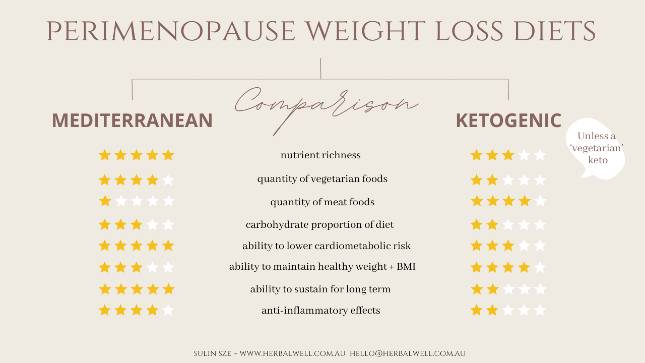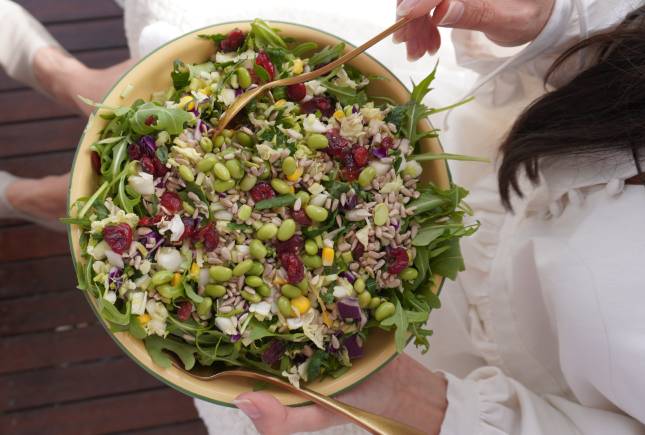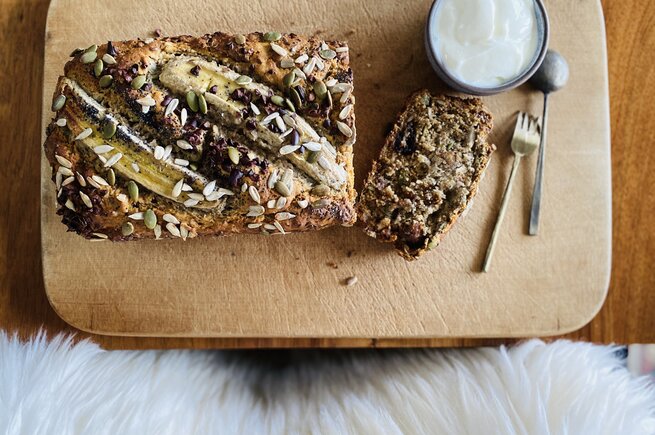Look no further for a current, evidence-informed review of the Mediterranean Diet for perimenopause. Did you know that one of the key hormone shifts in the 8-12 years before menopause is an increasing androgen to oestrogen ratio? This sets the scene for steady central fat gain as you move through perimenopause and makes it much harder to maintain a healthy BMI and if you’ve heard of the term ‘menopot’…this is one of the problems with this changing hormone ratio. I look at the Mediterranean Diet as possibly the most healthy diet for perimenopausal women wanting to maintain a healthy weight and lower their risk of cardio-metabolic diseases like diabetes, obesity and heart disease.
The Mediterranean diet has been described as a suitable diet for perimenopause. Is it? And how does Mediterranean compare with other popular weight loss diets in menopause and perimenopause? Like Keto for instance. In this article I’m looking what’s unique and nutritionally meaningful about the Mediterranean diet in the perimenopause phase, the pros and cons, and of course, what research has to say about it’s suitability for the transition period to menopause.
Some stats to bear in mind as you peruse this article:
- Menopause is a high-risk stage for weight gain in women. Total body fat increases as does waist circumference.1
- Visceral fat gain in perimenopause and menopause is not just about oestrogen falling. It’s actually due to a cascade of hormonal changes involving the thyroid, appetite hormones and adrenal hormones. Namely thyroid hormones T4 and T3 as well as reverse T3, leptin and ghrelin and cortisol.
- A 2018 pooled analysis of over 24,000 menopausal women found that nearly 39% of menopausal women were either overweight or obese.2
The Mediterranean diet is a super popular diet that’s known for lowering cardiovascular disease risk, being high in protein and natural antioxidants, promoting a healthy heart and lowering the risk of metabolic disease. It originated in an area called the ‘Mediterranean Basin’, this area is to historians as the ‘cradle of society’. It includes the civilisations of the Sumerians (who were actually the first civilisation to document herbal medicine), the Persians and the Babylonians. As a way of eating, it was influenced over time by Greeks and Roman cuisine, with the introduction of bread and wine and oil as well as seafood like salty fish. For many of us when we think of Mediterranean diet, we imagine this classic triad of bread, oil and wine, and of course, a lot of vegetables. But that’s not the full story!
The Mediterranean diet is essentially the Cretan diet of the 1950s and 1960s. It’s rich in vegetables, fruit, beans, seeds, nuts and cereals with a moderate intake of chicken, fish and wine. In the 1950s a physiologist called Ancel Keys (he passed away in 2004) devised the Mediterranean model to describe and document this diet approach, and so much of what we understand of it comes from his work.
Originally his goal was to examine any links between diet and coronary heart disease and he looked at the eating patterns of seven countries including Greece, US, Italy, Yugoslavia, Finland, Netherlands and Japan. He was especially interested in the cardiovascular benefits of the diet as a low animal-fat one, and how that could protect against heart disease. We know that diets high in animal fats were associated with increased risk of heart disease. Considering that perimenopause, menopause and postmenopause are associated with an increased risk of heart disease, it makes sense that this diet could be helpful.3
This diet emphasises lots of fibre, which can help your body remove fats, antioxidants and unsaturated fats and its about getting a healthy balance between the energy you’re eating and the energy you’re expending through physical exercise. While we’re so busy thinking about the hormonal chaos within, we forget sometimes that we need fibre to remove excess hormones. If our diets are fibre-poor, its going to be that much harder for us to maintain a healthy hormone balance.4
Here’s an overview of what the Mediterranean diet looks like:
- Plenty of plant foods (vegetables, legumes like chickpea, alfalfa, green beans, lentils and beans, also nuts and fruits)
- Whole-grain cereals
- Extra virgin olive oil (the main primary source of fat)
It’s got a strong anti-inflammatory and antioxidant theme, while providing more unsaturated fats (from foods like olives, avocados, nuts and seeds) which are definitely healthier than saturated fats that you find in foods like butter, bacon, biscuits, fatty meats and cheese.5
You’ll also find nuts play a role in this diet, because they’re rich in macronutrients (your macronutrients are protein, carbohydrate and fat) and they especially have a high proportion of unsaturated fat and fibre. In a 2022 study on the benefits of nuts for metabolic syndrome in menopause, researchers looked at high quality research (meta analyses and systematic reviews) and found that consuming a healthy amount of nuts as part of the diet slightly reduced blood pressure and fat accumulation and also had a beneficial effect on carbohydrate and fat metabolism. They were trying to see if there was any benefit in nuts for this stage of a woman’s life where there was high blood glucose levels, central fat accumulation, high insulin levels and hypertension as well. And they didn’t just use studies with weight and waist measurement data in their included papers, some of the studies used imaging technologies like CT scans to measure the lean and fat masses in participants. Talk about precision!6

Photo: Pixabay
Like more info?
Listen to my Well Woman episode for more insights into diets for healthy weight maintenance in menopause and perimenopause here.

The main fat-gain drivers in perimenopause
These are known and proven accelerants to weight gain in perimenopause and the first 1-2 years after menopause. We should be screening for all of them as soon we enter perimenopause, but how many of us in our late thirties or early forties have ever been offered a test for them? Unless you’ve been to see a naturopath, the chances are pretty slim. So much needs to change to make sure that women are supported, looked out for and monitored in the lead up to menopause and beyond!
- Changing androgen to oestrogen (oestradiol) ratio
- Changing metabolic landscape where your body needs to build metabolic flexibility
- Increased cortisol associated with chronic stress (whether you feel stress or not, remember, stress occurs on many levels including physiological, chemical and psychological)
- Hunger hormone confusion and the possibility of Leptin resistance and high Ghrelin are high unless you’re on a suitable diet for perimenopause (possibly not the same diet that worked for you 20 years ago)
- Changing Thyroid hormones including hypofunction which leads to a slower metabolic rate
- A history of yo-yo or fad dieting that’s left your hormones in disarray
Ever heard the phrase ‘eat the rainbow’?
Well that’s exactly what this diet is about. Typically in a day you’d be eating fruits and vegetables of various colours, with the colours each having specific properties. This rainbow approach to diet is fascinating, read on to find out what each colour food is good for and the chemistry behind it.
Dark green foods may be great sources of vitamin K and are best for cardiovascular health. Red foods are great for inflammation with their vitamin A, carotenoids, lycopene and astaxanthin (which are antioxidant plant chemicals that you’ll also find in tomatoes, cranberries and grapes). Orange foods would also be rich in vitamin A and carotenoids as well as playing a role in supporting hormonal health and regulation, improving fertility and ovulation for instance. Yellow foods benefit digestive function, often rich in fibre and helping maintain a healthy microbiome, gastric motility and digestive secretions that we all need to break down our food properly. Purple and blue foods would be rich in flavonoids with their antioxidant and anti-inflammatory chemistry (think procyanidins in grapes, blueberries, and quercetin, which helps reduce histamine symptoms and is one of my favourite anti-inflammatories, also phenolic acids and flavonoids. These chemicals are also thought to improve cognition, learning, memory, focus, as well as mood.
What does the research say about an eat the rainbow diet approach? It supports it! There was a 2011 study showing a 9% lower risk of stroke for every 25 grams of white fruits and vegetables eaten in a day, and for every 25 gram serve of orange fruits and vegetables you get a reduced risk of coronary heart disease, with carrots featuring high on the list offering a 32% reduced risk of heart disease.
You’d be eating apples, blood oranges, raspberries, cherries, bell peppers, beetroot, red onion and tomatoes to boost your antioxidant status and support immunity. You’d be eating carrots, pumpkin, turmeric, oranges, papaya, peaches, mandarins and sweet potato to flush your body with beta-carotene, bioflavonoids, carotenoids and curcuminoids to act as antioxidants, slow down the ageing process, support health hormones and boost your fertility naturally.
Then you’d be eating corn, yellow bell peppers, lemons, pineapple and golden delicious apples as yellow foods to give you bromelain, rutin, zeathanxin, lutein (so not only amazing for your digestive enzymes and gastric motility but also eye health) and generally supporting a healthy gut microbiome. With the green foods, they’re rich in chlorophyll, which is often alkalinising and helpful if you’re a little acidic. Here you’d be eating avocado, limes, pears, beans, broccoli, cabbage, edamame, rosemary and all your lush salad greens to get a boost of glucosinolates, folates, and well known antixodants like chlorogenic acid and catechins (they’re found in green tea there). These compounds offer antioxidant activity in your body, improve your circulation, support your blood vessel health which in turn helps the cardiovascular system function well. And finally we have the blue purple foods so here you’d be eating black and blueberries, prunes and raisins along with purple carrot, purple kale, eggplant and plums for their strong antioxidant activity with a host of plant chemicals like flavonoids, resveratrol, stilbenes and anthocyanidins, and the benefits from these are to lift cognitive function and balance mood. If you’re interested in reading more about this ‘eat the rainbow’ approach by the way get in touch, I can steer you in the direction of some further reading on it, it’s really fascinating and it makes sense!7
The benefits of the Mediterranean diet for perimenopause and menopausal symptoms has been trialled in Australian women aged 45-50 and they were all going through a natural menopause. It was done around a decade ago, and they looked at the differences between this diet, and diets high in processed meats and dairy, or high sugar diets. Overall the mediterranean diet came out tops for reducing night sweats and hot flashes, your typical vasomotor symptoms. Not surprisingly the high sugar and high fat diet increased the rates of these symptoms.8
I thought it would help to show you graphically the difference between the diets for a perimenopausal woman. Ideally fibre content would be included here too, and Mediterranean would get 4 stars for this, Ketogenic would get 1-2 stars. This is how I see the two diets measuring up for the main health concerns in perimenopause and menopause.

A note: the ketogenic diet should be tailored and tweaked to suit your body type if you’re thinking of doing this diet in perimenopause or menopause.
Okay, time to answer some questions….
Did you know you can ask me questions about womens health and I’ll answer them either on my socials, podcast or here in the blog? Email me or DM me via the socials. All questions are welcome, and there’s no such thing as a silly question.
Is the Mediterranean diet ‘carby’?
Not really, it’s more of a low-carb option really. Like the ketogenic diet, the emphasis is on healthy fats and protein, but what I love about it is the fibre and the anti-inflammatory aspects, this is where it moves into the territory of a medicinal diet that caters especially well to the pro-inflammatory metabolic changes we see in the lead up to menopause. And in terms of our global diabetes epidemic, it’s one of the better diets to be on with its positive effects on blood glucose levels. According to Stanford Medicine it’s the easier of the two diets that are particularly good for managing or preventing diabetes, with the other diet being the ketogenic diet. Their randomised study observed around 40 participants over a 12 week period and was published in the American Journal of Clinical Nutrition last year (2022). It revealed that the Mediterranean diet was just as effective as the highly carbohydrate-restrictive ketogenic diet in controlling blood glucose levels in diabetic patients.9
This means Mediterranean is a fantastic diet choice if you’re one of those women in perimenopause or menopause who’ve been concerned about rising glucose levels on your blood tests, or even had a high HbA1c (glycosylated haemoglobin) result, which is used as a clinical indicator for diabetes. They looked at the effects of these two diets on blood glucose levels, risk factors for cardiovascular and metabolic disease, weight loss as well as general nutritional status, and they also assessed how easy it was to maintain these diets. Because we all know that it’s one thing to embark on a new diet and it’s another thing to be able to maintain that diet and sustain it for long enough to reap the benefits from it!
Both diets did very well at controlling the blood glucose levels and assisting with weight loss, good news if this is your intention. After the 12 week period both diet were able to reduce triglycerides and weight. The ketogenic diet reduced weight by an average of 8% (considering scientists estimate weight gain in menopause to be 1Kg a year for most women, this is a great achievement!) and Mediterranean reduced weight by an average of 7%). And I know I’m perhaps repeating myself here, but please know that if you’re in perimenopause it’s highly likely there will be some weight gain. If you’re actually losing weight instead, well done you! The two diets also led to an increase the healthy version of cholesterol, the HDLs (high density lipoproteins) which are markers for improved cardiovascular health. But the ketogenic diet increased the LDLs (the low density lipoproteins) and that’s not particularly good as higher LDL levels indicate increased cardiovascular disease risk. Overall the patients on the Mediterranean diet were eating more fibre and more nutrients by the end of the study making it the more sustainable diet of the two.9
When the two diets were compared for their nutritional value Mediterranean scored better than ketogenic, particularly in fibre which I would say is possibly more important for healthy hormone balance. Nutritionist Christopher Gardner had an interesting comment about the benefits of keto versus Mediterranean, he said “The lower in carbs you go, the more you’re wiping out entire food groups that are considered very nutrient dense and healthy.” “What is it about this diet that would be so compelling that you would give up some of those central tenets of health and Nutrition?” Which does beg the question that keto may be more of a Weight Loss Diet really, at the end of the day, not necessarily a health diet. Not saying that it isn’t healthy for some of us, but maybe not the best choice if you’re really health focused and you want to eat food which has always been one of the recommendations for good nutrition. 9 10
With all this talk about getting enough protein…is it really a good idea to have a low meat intake?
Sometimes we get a little fixated on the elements of a diet without seeing it in it’s totality. First up, the benefits of eating a low-meat diet would be reduced risk of some of the modern conditions associated with a high meat intake. Think along the lines of obesity, visceral fat gain, cardiovascular disease. To illustrate this point, there was a 2006 study on premenopausal women and their risk of breast cancer, comparing the meat eaters to the non-meat eaters. There were over 90,000 women in the study and it was conducted over a 12 year period which means we get incredible insights into the health of these women before they embark on a crazy hormonal perimenopausal transition, and where they’re at at the end of it all.11
Researchers found that a higher red meat intake was strongly related to an increased risk of breast cancer. It was a little higher for the oestrogen receptor-positive breast cancers compared to the progesterone receptor-positive ones. Overall the researchers concluded that eating red meat more than 3 times a week was problematic when it came to breast cancer risk.11
Can you use spices in this diet?
Absolutely, in fact the Mediterranean diet just wouldn’t be the same without spices. If you look at typical Mediterranean recipes you’ll see this diet is already infused with the spices from the Orient. They were originally introduced by Arabics and the Turkish Empire.12 Spices like cinnamon, cardamom, clove, ginger, turmeric and nutmeg travelled the seas between East and West and travelled camel-style along the Silk Road. They were part of a lucrative and complicated history of spice trade between India, Indonesia, the Middle East and across the Mediterranean to Europe. If you love spices, this diet is probably going to seem like second nature to you.
The most common spices used in this diet are basil, coriander, parsley, Oregano, paprika, black pepper, marjoram, cloves, fennel, dill, rosemary, lavender, garlic, bay leaf, sage, saffron, thyme, sumac and tarragon.8
What makes this diet so healthy for women at this life stage?
Well when you have this combination of natural fresh foods, fruits, fibre and low saturated fats you get a lower intake of trans fatty acids. And together with the high fibre intake you get better hormone clearance and regulation.
In the case of perimenopause where oestrogen skyrockets and then dives and can get into an unhealthy loop of highs and lows, clearing excess hormones is thought to be one reason why there are fewer vasomotor symptoms with this diet.
Also the effects on blood glucose are really important to note, because regulating blood glucose levels and avoiding resistance issues with insulin and leptin is one way you can maintain a healthy weight through perimenopause and postmenopause. With the mediterranean diet there are more low glycaemic index (Low GI) foods, which translates to lower glucose levels after meals that decline more gradually, meaning you’re not getting the spikes and falls which can trigger cravings and fatigue.
One more thing, the effects on inflammation. Perimenopause is a great inflammatory event. It’s the time of your life where you’ll start to see all these random symptoms emerging, food intolerances, itchy eyes or blepharitis, vaginitis, arthritis…..notice the ‘itis’ at the end of all of those, medically this is a reference to an inflammatory state. This is one diet that’s truly geared to reduce inflammation and oxidation in your body, its rich in the flavonoids, quercetin, polyphenols and catechins that are all chemicals we use in herbal medicine as therapeutic agents for a range of inflammatory conditions. and research shows us that this diet can lower inflammatory biomarkers which are more common in women with vasomotor symptoms like hot flashes, night sweats and joint pain.8
Is this the most wholesome diet?
I would argue that it is because it’s a nice blend of nutrient density and lowering disease risks for conditions that are more risky in menopause. On the nutrient side, you get lots of minerals and wholesome nutrition from the legumes (the beans and lentils for example, which have a high protein character and can be used as meat substitutes in many instances). The legumes are also rich in fibre, vitamin B, minerals like calcium and potassium which are so important for bone health, as well as zinc, probably the most important mineral for hormonal regulation.
Best thing though about legumes, is they’re low glycaemic index, and great news if you’re battling insulin resistance, cravings, insatiable appetite or weight gain. A paper published in the journal Frontiers in Endocrinology in 2022 revealed that if you eat more legumes you have fewer menopausal symptoms while eating extra virgin olive oil was associated with fewer psychological symptoms.5 The study looked specifically at women in postmenopause with obesity so age-wise, its older than your typical perimenopausal woman. The average age was 57 in the study.
I’d also say it’s a medicinal diet. The antioxidant properties in the mediterranean diet come in part from the fruits and emphasis on fresh foods, but also from the beans and other legumes which are rich in antioxidants like flavonoids, lignans, tannins and phenolic acids and that might sound like a lot of chemistry there, just know that these are plant chemicals we study in naturopathy and they’re known to be not only antioxidant but anti-inflammatory too.13
Summing up
I really love the balance and wisdom in the Mediterranean diet and if you’re looking for better cardiometabolic health and healthy weight management, it’s a great choice in perimenopause.
It can help reduce blood glucose levels if they’re high, give you a lot of healthy foods from all the food groups and colours of the rainbow which as you know now, is beneficial for far more than just weight balance. As a plantet-lover and low meat-eater I love its emphasis on plant proteins. This diet would suit a meat-eater who’s looking to eat more vegetarian, or a vegetarian who might be dealing with low iron, poor energy or weight gain, or is maybe just wanting to broaden into a little meat.
The key benefits for a perimenopausal woman with the Mediterranean diet really comes down to it’s ability to improve your cardio-metabolic profile, contributing to a lowered risk of conditions associated with being postmenopausal. You may lose some weight too, but that depends on maintaining the lifestyle and exercise aspects of healthy living, and you’ won’t lose as much as you would on a tweaked ketogenic or low carb diet, but here’s the thing…you’ll maintain the weight loss for longer compared to those two diets. They’re harder to sustain over the long term.
There are benefits for your bone density too, and studies have found the Mediterranean diet can be helpful in depression and low mood. Because of the anti-inflammatory aspects of this diet, its been associated with a lowered risk of breast cancer.12

Photo: Lee Holmes 2023
Changing diet timeframe
If you’re thinking of switching up your diet to generate metabolic flexibility, lose some weight and curb the cravings for good, then here are a couple of things to bear in mind. Changing your diet is a journey, it’s not usually a quick process. For most of humble mortals, it takes time to actually transform our internal landscape and its behaviours and patterns. We’re trying to shift our eating behaviours and embrace a whole new approach to nutrition. It’s going to change the way we think about food and its function, the way we shop, the way we assess what’s serving our bodies best. Give yourself plenty of time to shift into a your new fabulous diet routine, and I’m not talking about 10 days, I’m thinking more like 6 months to a year. Basically, give yourself longer than you would expect it to take. You can do this! Step by step, decision by decision. That’s how we reframe our health story and all the chapters within it.
And if you tend to want things happening quickly, and I can totally understand this around health and body shape (there’s nothing worse than not feeling ourselves or feeling un-well) then just remind yourself that you’re a work in progress and you’re in the act of transforming.
You need to commit long term to the Mediterranean diet to see its benefits fully, so plan on adopting this eating pattern over the long term, and know that its predominantly plant based. There’s also an assumption that you’re physically active and maintaining a healthy lifestyle. So if you have a sedentary lifestyle you may not see the same benefits as those observed in clinical trials. That means regular exercise, 3 times a week, 30 minutes at a time, and the type of exercise that lifts your heart rate.
For anyone with a background of metabolic imbalance (think conditions like insulin resistance, leptin resistance, elevated ghrelin, low thyroid hormones or adrenal exhaustion) I would recommend having a consultation with me to get you onto some nutritional and herbal support supplements. I’ve seen so often in clinic that it’s best to have the blend of both a suitable diet and support supplements to get things moving in these cases. The area of challenge is that your hormonal landscape is currently dysfunctional and that’s a hard place to start from. Herbs can be formulated to target hormonal and metabolic imbalances precisely, right down to your daily dose and the ratio of each herb in the mixture.
What ever you decide to do at the end of the day, I wish you every success with your diet transformation!


Hey there! Welcome to my world of totally natural and powerful healing medicines. Medicines from nature. Medicine from Source. I’m a naturopath and herbalist with extensive clinical experience working with a range of health conditions including hormonal, metabolic, mental health, sleep and more.
I’ve brought together years of clinical and teaching experience, academic skill and curiosity to bring you this blog. I hope you enjoy it! If you do, leave a comment, I’d love to hear from you!

References
- Chopra, S., Sharma, K. A., Ranjan, P., Malhotra, A., Vikram, N. K., & Kumari, A. (2019). Weight management module for perimenopausal women: A practical guide for gynecologists. Journal of mid-life health, 10(4), 165.
- Zhu, D., Chung, H. F., Pandeya, N., Dobson, A. J., Kuh, D., Crawford, S. L., … & Mishra, G. D. (2018). Body mass index and age at natural menopause: an international pooled analysis of 11 prospective studies. European journal of epidemiology, 33, 699-710.
- Yngve, A. (2009). A historical perspective of the understanding of the link between diet and coronary heart disease. American journal of lifestyle medicine, 3(1_suppl), 35S-38S.
- Altomare, R., Cacciabaudo, F., Damiano, G., Palumbo, V. D., Gioviale, M. C., Bellavia, M., … & Monte, A. I. L. (2013). The mediterranean diet: a history of health. Iranian journal of public health, 42(5), 449.
- Vetrani, C., Barrea, L., Rispoli, R., Verde, L., De Alteriis, G., Docimo, A., … & Muscogiuri, G. (2022). Mediterranean diet: what are the consequences for menopause?. Frontiers in Endocrinology, 13, 886824.
- Bauset, C., Martínez-Aspas, A., Smith-Ballester, S., García-Vigara, A., Monllor-Tormos, A., Kadi, F., … & Cano, A. (2022). Nuts and metabolic syndrome: Reducing the burden of metabolic syndrome in menopause. Nutrients, 14(8), 1677.
- Griep, L. M. O., Verschuren, W. M., Kromhout, D., Ocké, M. C., & Geleijnse, J. M. (2011). Colours of fruit and vegetables and 10-year incidence of CHD. British Journal of Nutrition, 106(10), 1562-1569.
- Herber-Gast, G. C. M., & Mishra, G. D. (2013). Fruit, Mediterranean-style, and high-fat and-sugar diets are associated with the risk of night sweats and hot flushes in midlife: results from a prospective cohort study. The American of Clinical Nutrition, 97(5), 1092-1099.
- Gardner, C. D., Landry, M. J., Perelman, D., Petlura, C., Durand, L. R., Aronica, L., … & Kim, S. H. (2022). Effect of a ketogenic diet versus Mediterranean diet on glycated hemoglobin in individuals with prediabetes and type 2 diabetes mellitus: The interventional Keto-Med randomized crossover trial. The American Journal of Clinical Nutrition, 116(3), 640-652.
- Bai, N (2022) Keto and Mediterranean diets both help manage diabetes but one is easier to maintain. Stanford Medicine.
- Cho, E., Chen, W. Y., Hunter, D. J., Stampfer, M. J., Colditz, G. A., Hankinson, S. E., & Willett, W. C. (2006). Red meat intake and risk of breast cancer among premenopausal women. Archives of internal medicine, 166(20), 2253-2259.
- Cano, A., Marshall, S., Zolfaroli, I., Bitzer, J., Ceausu, I., Chedraui, P., … & Rees, M. (2020). The Mediterranean diet and menopausal health: An EMAS position statement. Maturitas, 139, 90-97.
- Del Socorro López Cortez, M., Rosales-Martínez, P., Arellano-Cárdenas, S., & Cornejo-Mazón, M. (2016). Antioxidants properties and effect of processing methods on bioactive compounds of legumes. Grain legumes. London, UK: IntechOpen Ltd, 103-26.




